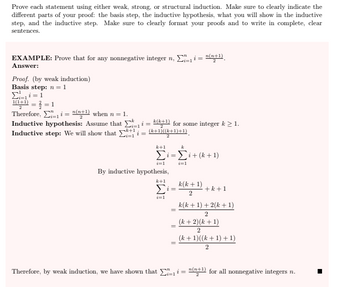
Operations Research : Applications and Algorithms
4th Edition
ISBN: 9780534380588
Author: Wayne L. Winston
Publisher: Brooks Cole
expand_more
expand_more
format_list_bulleted
Question

Transcribed Image Text:Consider the set S of strings defined recursively in Problem 1.
Prove that for any given string in S, the number of a's in it is the same as the number of b's in it.

Transcribed Image Text:Prove each statement using either weak, strong, or structural induction. Make sure to clearly indicate the
different parts of your proof: the basis step, the inductive hypothesis, what you will show in the inductive
step, and the inductive step. Make sure to clearly format your proofs and to write in complete, clear
sentences.
EXAMPLE: Prove that for any nonnegative integer n, Σ i = (n+1)
Answer:
Proof. (by weak induction)
Basis step: n = 1
Σ=1
1(1+1)==1
Therefore, (n+1) when n = 1.
=
Inductive hypothesis: Assume that
Inductive step: We will show that
i=1
i=1
i=
= (+1) for some integer k > 1.
i= (k+1)((k+1)+1)
k+1
Σ=Σ+ (κ + 1)
i=1
By inductive hypothesis,
k+1
Σ
IME
i=1
k(k+1)
=
+k+1
2
k(k+1)+2(k+1)
=
2
(k+2)(k+1)
=
2
(k+1)((k+1)+1)
2
Therefore, by weak induction, we have shown that = (n+1) for all nonnegative integers n.
Expert Solution
This question has been solved!
Explore an expertly crafted, step-by-step solution for a thorough understanding of key concepts.
Step by stepSolved in 2 steps

Knowledge Booster
Similar questions
- (Program) Write a program that tests the effectiveness of the rand() library function. Start by initializing 10 counters, such as zerocount, onecount, twocount, and so forth, to 0. Then generate a large number of pseudorandom integers between 0 and 9. Each time 0 occurs, increment zerocount; when 1 occurs, increment onecount; and so on. Finally, display the number of 0s, 1s, 2s, and so on that occurred and the percentage of time they occurred.arrow_forwardThe implementation of a queue in an array, as given in this chapter, uses the variable count to determine whether the queue is empty or full. You can also use the variable count to return the number of elements in the queue. On the other hand, class linkedQueueType does not use such a variable to keep track of the number of elements in the queue. Redefine the class linkedQueueType by adding the variable count to keep track of the number of elements in the queue. Modify the definitions of the functions addQueue and deleteQueue as necessary. Add the function queueCount to return the number of elements in the queue. Also, write a program to test various operations of the class you defined.arrow_forward
Recommended textbooks for you
 Operations Research : Applications and AlgorithmsComputer ScienceISBN:9780534380588Author:Wayne L. WinstonPublisher:Brooks Cole
Operations Research : Applications and AlgorithmsComputer ScienceISBN:9780534380588Author:Wayne L. WinstonPublisher:Brooks Cole C++ Programming: From Problem Analysis to Program...Computer ScienceISBN:9781337102087Author:D. S. MalikPublisher:Cengage LearningProgramming Logic & Design ComprehensiveComputer ScienceISBN:9781337669405Author:FARRELLPublisher:Cengage
C++ Programming: From Problem Analysis to Program...Computer ScienceISBN:9781337102087Author:D. S. MalikPublisher:Cengage LearningProgramming Logic & Design ComprehensiveComputer ScienceISBN:9781337669405Author:FARRELLPublisher:Cengage C++ for Engineers and ScientistsComputer ScienceISBN:9781133187844Author:Bronson, Gary J.Publisher:Course Technology Ptr
C++ for Engineers and ScientistsComputer ScienceISBN:9781133187844Author:Bronson, Gary J.Publisher:Course Technology Ptr Systems ArchitectureComputer ScienceISBN:9781305080195Author:Stephen D. BurdPublisher:Cengage Learning
Systems ArchitectureComputer ScienceISBN:9781305080195Author:Stephen D. BurdPublisher:Cengage Learning LINUX+ AND LPIC-1 GDE.TO LINUX CERTIF.Computer ScienceISBN:9781337569798Author:ECKERTPublisher:CENGAGE L
LINUX+ AND LPIC-1 GDE.TO LINUX CERTIF.Computer ScienceISBN:9781337569798Author:ECKERTPublisher:CENGAGE L

Operations Research : Applications and Algorithms
Computer Science
ISBN:9780534380588
Author:Wayne L. Winston
Publisher:Brooks Cole

C++ Programming: From Problem Analysis to Program...
Computer Science
ISBN:9781337102087
Author:D. S. Malik
Publisher:Cengage Learning

Programming Logic & Design Comprehensive
Computer Science
ISBN:9781337669405
Author:FARRELL
Publisher:Cengage

C++ for Engineers and Scientists
Computer Science
ISBN:9781133187844
Author:Bronson, Gary J.
Publisher:Course Technology Ptr

Systems Architecture
Computer Science
ISBN:9781305080195
Author:Stephen D. Burd
Publisher:Cengage Learning

LINUX+ AND LPIC-1 GDE.TO LINUX CERTIF.
Computer Science
ISBN:9781337569798
Author:ECKERT
Publisher:CENGAGE L